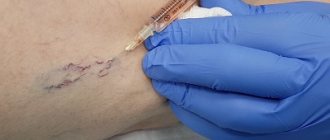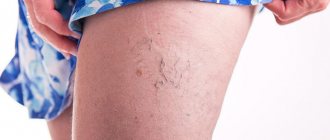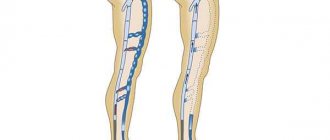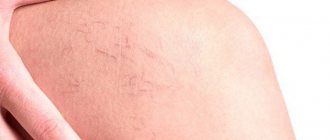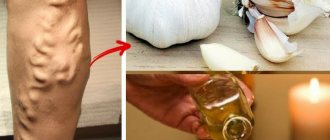Pain in the legs due to varicose veins is a complaint that patients often present when visiting doctors. In the presence of varicose leg pain, phlebologists at the Yusupov Hospital conduct a comprehensive examination of patients using physical and instrumental diagnostic methods. For ultrasound examinations, the latest devices from the world's leading manufacturers are used, which have high resolution and allow the patient to be examined in one, two or three modes.
Conservative treatment of patients who have pain in varicose veins in the legs is carried out with the latest generation of medicines. Their effectiveness and safety have been proven by scientific research. Highly qualified surgeons and the presence of modern equipment and surgical instruments in the phlebology department allow phlebologists to perform operations using both classical and innovative techniques.
Severe cases of varicose veins, when pain due to varicose veins in the legs is not relieved by medications, are discussed at a meeting of the expert council with the participation of candidates and doctors of medical sciences, doctors of the highest qualification category. Leading specialists in the field of diseases of the peripheral venous system collectively decide how to reduce pain from varicose veins of the legs. If pain in a vein in the leg due to varicose veins does not go away as a result of adequate conservative therapy, patients are offered surgical intervention. Surgeons perform the operation only after obtaining the patient's informed consent.
Do the veins in your legs hurt? How to get rid of pain from varicose veins
With each day approaching warm spring and summer, some groups of people are more often thinking about the form of clothing that they will have to wear so as not to cause aesthetic discomfort to themselves and others.
It's all about varicose veins in the legs. If you are familiar with the feeling of “tired legs”, unusual bursting pain in the limbs in the evening after a hard day at work, swelling that does not allow you to fit into the right shoe size, then chronic venous insufficiency is already on the threshold. The most important thing to do is to prevent the disease from further developing into varicose veins, when blue spider veins and swollen silhouettes of veins appear on the legs.
Symptoms
Chronic venous insufficiency is manifested by the following main symptoms:
- pain in the calf muscles of the legs due to decreased tone of the venous wall and oxygen starvation;
- heaviness in the lower extremities;
- convulsions;
- swelling of the legs in the evening due to overload of the lymphatic system, increased capillary permeability and inflammatory reactions;
- constant skin itching.
A characteristic feature of pain in chronic venous diseases is its localization in the calf muscles. Venous pain in the legs is never sharp and does not radiate to the thigh or foot. The pain is moderate, nagging, dull. They appear in the evening and disappear after a night's rest. Acute pain in the lower extremities in patients with varicose veins occurs due to inflammation of the vein (thrombophlebitis) or thrombosis of the deep veins of the leg.
Who most often suffer from leg vein pain?
According to the latest data from the World Health Organization, 60% of working-age residents of developed countries suffer from varicose veins. Moreover, venous disease is one and a half times more common among the fair sex. This is due to the genetic predisposition of women to varicose veins, as well as to the factor of their reproductive function. During pregnancy, women experience some restructuring of the balance of the hormonal system, which causes an increase in body weight, as well as the total volume of blood circulating in the body of the expectant mother. All this, with each subsequent month of pregnancy, negatively affects the vascular wall, as well as the pelvic vessels.
Therefore, if you notice the symptoms of heaviness in the legs described above, it is recommended to immediately make an appointment with a phlebologist and come for an examination and diagnosis.
How is surgery for varicose veins performed?
Symptoms of varicose veins at a late stage
If the disease has reached the stage of decompensation, then the symptoms appear so clearly that seeing a doctor becomes vital. At a late stage, varicose veins are dangerous for the development of dangerous complications, so treatment should be started immediately.
If varicose veins are in the stage of decompensation, then in addition to the existing symptoms: pain and heaviness in the legs, swelling, cramps, itching, a change in skin pigmentation is added, it acquires a bluish or brown tint. Stagnation of blood in the veins leads to disruption of tissue nutrition, resulting in trophic disorders. Ulcers, weeping spots, poorly healing or non-healing wounds appear on the skin.
If such changes begin, then varicose veins can be treated only after the wounds on the skin have been healed. Thus, the total duration of treatment increases markedly. As for varicose veins, they may require surgical removal.
Hippocrates said: “Both success and failure in treating a disease must be attributed to both the doctor and the patient.” If you are attentive to your health, then do not miss the first symptoms of varicose veins, consult a doctor in time and you will be able to maintain the health and beauty of your legs for a long time.
Why do the veins in my legs hurt?
Most often, phlebology experts associate the appearance of pain, and then chronic venous insufficiency, with a hereditary factor (genetic predisposition). For example, if the father and mother had a history of varicose veins, then there is an 89% chance that the child will develop varicose veins. And if dilated veins were observed in only one of the parents, then the risk of varicose veins is about 50%.
Cure varicose veins
Other factors for the appearance of varicose veins:
- passive lifestyle;
- regular long-term standing position (for example, after half an hour of standing on your feet, the volume of blood in the veins of the lower extremities increases to 300 milliliters. Imagine how the load on the venous vessels increases);
- frequent air travel, long car trips (relevant for truck drivers);
- power failures;
- excess weight;
- hormonal imbalance;
- presence of chronic diseases;
- frequent stressful conditions.
As a result of the influence of the combination of the described factors, the walls of the venous vessels become thinner, their elasticity is impaired, which leads to the accumulation of blood in certain areas of the vein. The vessel becomes visible, convex and thickened.
Treatment of varicose veins of the lower extremities
The essence of conservative treatment of varicose veins is to restore normal venous outflow.
Physical exercise
Walking is recommended for patients with varicose veins as a method of both prevention and treatment. Contracting the leg muscles helps pump blood to the heart and improves circulation.
Wearing compression garments
The use of compression stockings is one of the conservative methods of treating varicose veins and other vein lesions. The products provide a compressive effect to maintain vascular tone and restore blood flow to the affected area of the lower extremities. It is important to change your underwear regularly, as they tend to stretch.
Medicines
Medicines for the treatment of varicose veins should increase the tone of the veins, reduce capillary permeability and improve lymphatic drainage, microcirculation and eliminate rheological disorders and stop inflammation. Drugs for the treatment of varicose veins are divided into several groups. Phlebotonics: detralex, venarus, phlebodia 600, glivenol, venoruton, ginkor-fort, anavenol and others; anticoagulants: clexane, fraxiparine; anti-edema medications: phlebodia 600, detralex; antiplatelet agents: ticlid, vasobral, aspirin, doxium; for trophic changes: glivenol, phlebodia 600, actovegin, ginkor-fort; antioxidants: ginkort-fort, vitamin E; aspirin and its derivatives; non-steroidal analgesics; fibrinolytics.
Doctors also recommend the use of topical medications - ointments and gels. This helps reduce pain in the limbs and reduce swelling, improve the functioning of the valve system, increase the tone of the vascular walls, and restore normal blood flow.
What are the stages of varicose veins?
The insidiousness of dilated veins in the chronic, invisible course of the disease. If the problem is not detected in a timely manner, at a stage when it has already become visible, serious complications can occur in the future. Chronic failure has three main stages:
- The presence of a permanent feeling of “tired” legs, the appearance of swelling in the evenings, painful sensations of a dull nature, as well as the formation of spider veins.
- The appearance of trophic pathologies in the legs is noted due to changes in biochemical processes in the tissues of the veins. The swelling becomes even more pronounced and is accompanied by itching, sometimes cramps, as well as aching pain radiating to the inner bends of the knees. The walls of the venous vessels become convex and visible to the naked eye. Often it is at this stage that the patient turns to the clinic for the help of a phlebologist, focusing primarily on the increasingly unaesthetic appearance of the lower extremities.
- The patient is bothered by severe swelling and pain in the legs, thrombophlebitis and blood supply disorders are diagnosed, and trophic ulcers occur.
Vascular surgeons warn that fatigue in the legs, dull pain in the legs in the evenings are signs of impaired blood supply in the veins, so it is necessary to consult a doctor in advance so as not to end up on the operating table.
The disease progresses: main symptoms
Very often, we mistake early manifestations of the disease for signs of leg fatigue: the symptoms of varicose veins on the legs really resemble the condition after prolonged exercise. However, you should be wary of the fact that the “fatigue” of the legs repeats again and again.
If varicose veins enter the subcompensation stage, then convoluted, convex veins and bluish venous nodules become clearly visible under the skin. Pain is added to the feeling of heaviness and fatigue in the legs. Swelling of the legs, which at an early stage went away during a night's sleep, now persists even after rest. Night cramps are becoming more common.
Seeing a doctor with such symptoms of varicose veins of the lower extremities requires more serious treatment. You may need not only sclerotherapy, but also laser treatment (EVLT) or radiofrequency ablation (RFA). For each patient, the phlebologist develops an individual comprehensive therapy program.
Dilated veins. causes and treatment of varicose veins
Chronic venous insufficiency of the lower extremities remains an important medical and social problem to this day. Everyone is probably familiar with the feeling of “heavy legs,” slight swelling in the ankle area, and an unpleasant “buzzing” sensation in the legs at the end of the day, making it difficult to fall asleep. Many women find “cobwebs” appearing on their legs, blue networks of small veins, and varicose veins. But few people realize that these are manifestations of an existing chronic disease. Today, more than 35 million Russians need operations on the veins of the legs, and more than 2 million are terminally ill or already disabled.
Varicose veins of the lower extremities is a disease of the valves of the veins, as a result of which blood circulation in the vessels of the lower extremities is impaired. One of the first manifestations of varicose veins is heaviness and discomfort to the point of pain in the legs, which usually intensify in the evening and completely disappear after sleep. The opposite situation also happens, when the patient has varicose veins and they are visible to the naked eye, but there are no clinical manifestations. Quite often, the patient is bothered by night cramps, pain in the legs, itching and redness of the skin, which indicates an advanced stage of the disease.
In later stages, trophic ulcers occur, which are extremely difficult to treat conservatively and can persist for years.
A terrible complication of this disease is thrombosis of the veins of the lower extremities and thromboembolism of the pulmonary arteries, which in turn leads to the death of the patient! It must be remembered that this complication can occur at any stage of the disease.
Causes of varicose veins.
- Heredity.
- Overweight.
- Female.
- Pregnancy.
- Use of hormonal contraceptives.
- Smoking.
- Sports activities that involve lifting weights.
- Prolonged vertical loads at work.
- Flat feet.
- Wearing high-heeled shoes.
Poor circulation due to varicose veins. Heaviness and pain in the legs
Normally, blood moves through the veins up towards the heart. To prevent blood from falling down under the influence of gravity, there are valves in the veins of the lower extremities. A valve is a “device” that prevents blood from flowing back. Valves in the veins of the lower extremities are located along the entire length of the vessel. As a result of varicose veins, the valves stop holding blood and it rushes in the opposite direction from the heart. As a result of this, blood stagnates in the vessels of the lower extremities, as a result the vein expands, thickens and becomes visible.
Treatment of varicose veins
The main goal of treatment is to restore normal blood circulation in the vessels of the lower extremities. This problem can only be solved surgically. All other methods are auxiliary and do not eliminate the cause of the disease (reverse blood flow in the altered vein).
Conservative therapy is a treatment method that uses tablets, ointments, and physical therapy. This method is aimed at reducing symptoms (swelling, pain, leg cramps). At the moment, there are no medications (tablets, ointments) that would have a preventive effect or remove varicose veins on the legs. While taking these drugs, the disease continues to progress (even if the patient clinically notes an improvement in the condition)!
Compression therapy is a treatment method based on the use of medical products (stockings, tights, elastic bandages) that exert a certain pressure on the lower limb. This type of treatment improves microcirculation, relieves swelling, and prevents thrombosis and thromboembolism. However, it also does not eliminate the cause of the disease. Constantly wearing compression stockings causes discomfort to the patient, and stopping wearing the stockings leads to the resumption of all symptoms of the disease. But you need to understand that compression therapy should be used at any stage of the course of varicose veins.
Surgical treatment of varicose veins of the lower extremities.
There are currently two types of operations. Open surgical interventions, when the damaged vein is removed through large skin incisions.
Performing an operation using the “open” view method
This operation is performed in a hospital using anesthesia. This operation is followed by a long (up to 3-6 months) period of recovery and disability. In the postoperative period, there are a lot of side effects in the form of decreased sensitivity, “chilliness,” especially in the cold season. Don't forget about the consequences of anesthesia. In world practice at present, this operation takes up no more than 10-12% of the total number of surgical interventions.
The second type is the so-called “closed” operations (endovenous thermoobliteration of veins with various types of energy). A type of such operations is EVLT - endovenous laser coagulation of veins. Currently, this method is the leading one in the treatment of varicose veins of the lower extremities. Unlike open surgery, the procedure takes from 20 to 60 minutes, does not require anesthesia, does not lead to disability (if the work does not involve heavy physical activity), and is performed without incisions on the skin, under local anesthesia.
The method is based on the fact that, under ultrasound control, a light guide is inserted into the altered vein through which the vein is “welded” from the inside with a laser beam.
Subsequently, within 2-6 months, the vein “resolves.” Restoration of normal blood circulation occurs on the operating table.
In the postoperative period, the following restrictions apply: wearing compression underwear (stockings) for 3 weeks, the first three days around the clock; Limiting lifting more than 10 kg for 3 weeks; abstaining from visiting the sauna, bathhouse and solarium for 2 months.
Advantages of the technique: no significant pain after surgery, the ability to walk “right off the table”, no incisions and no need for dressings, no need to stay in hospital, high therapeutic and cosmetic results, observation from the first visit to cure by one specialist, you can drive a car and do hard work. All this was appreciated first of all by the patients themselves (especially those who had previously undergone vein surgery under anesthesia using a traditional method or suffered for a long time from a trophic ulcer) - in their opinion, now it is possible to treat veins as simply as teeth.
Vascular surgeon-phlebologist R. Yu. Budkov performs EVLT surgery
This is not scary because you are not going to have an operation, but a manipulation; it is carried out quickly and requires only local anesthesia.
This is fast, because in one hour it relieves you of varicose veins on the legs and its symptoms (swelling, pain in the legs, cosmetic problems, ulcers, itching and darkening of the skin).
This is beautiful because there will be no postoperative scars and dilated veins, and you can live with open legs without embarrassment about their appearance, go to the pool, enjoy a beach holiday, wear shorts, short skirts and dresses.
It is modern and convenient as you will return to your normal life 1 day after treatment.
This is promising because you can start playing sports, working with full physical dedication, dancing and doing much more because now you DO NOT have VARICOSE.
Before
After
Before
After

